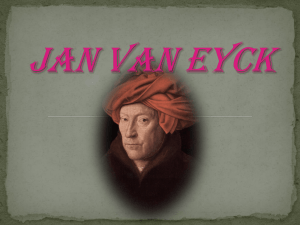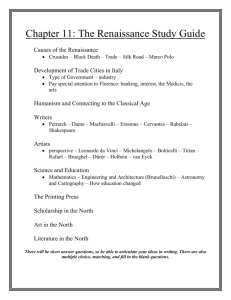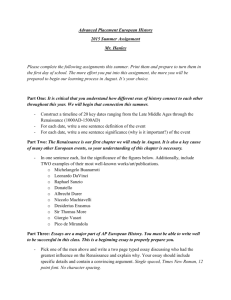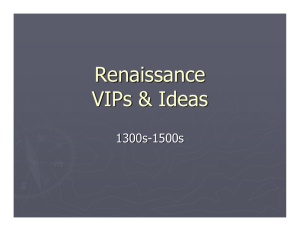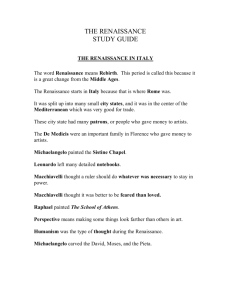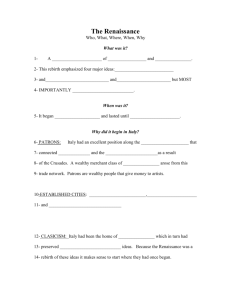Italy - learn2design
advertisement
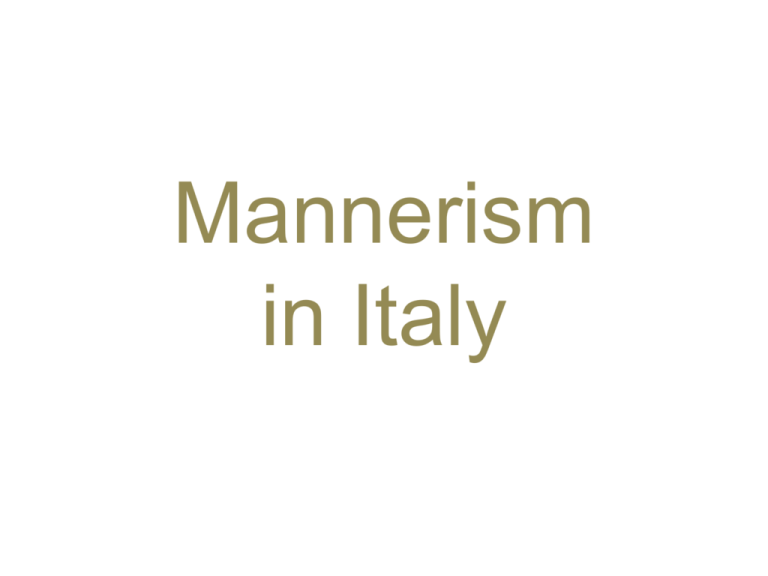
Mannerism in Italy Mannerism (In Italy 1520-1580, everywhere else - lasted until 17th Cent.) • Born as a reaction against naturalism, order and balance of the High Renaissance • “Maniera” (Italian) - style, stylishness • Intellectual sophistication – work directed towards a small audience who understands art • It’s art based on art, not art based on nature • Artificial, highly theatrical, dramatic lighting effects, exaggerated emotions, elongated figures, etc. Mannerism Entombment, Pontormo, 1525-28 http://smarthistory.org/pontormo-entombment.html Northern Renaissance North. Renaissance – 1400-1520 • Is the term used to describe the Renaissance in Northern Europe (England, France, Germany, Netherlands). North. Renaissance – 1400-1520 • Universities, the printed press and the development of trade helped to spread ideas throughout Europe. Northern Renaissance - Medium: • Oil on panel (used due to wet, cold climate) • Brighter, richer and deeper colors, smoother transitions, more realistic 3D rendering • Small scale wood panels - are easy to transport & view in a private, domestic setting - helped the middle class to create an illusion of wealth and high social status • Panels were treated as precious objects that are part of the spectator’s world and at the same time set off from the mundane world of everyday existence. Italian vs Northern Renaissance Italy - Subject matter: Classical mythology and religious iconography, portraiture much less common than in Netherlands Northern Europe - Subject matter: Domestic interiors, portraits and religious scenes Jan Van Eyck Was an official court artist in Brugges (Belgium) Is known for a microscopictelescopic vision: an exceptionally realistic style of painting Invented oil paint His is full of religious symbolism Man in a Red Turban (Self-Portrait), Jan van Eyck, tempera and oil on panel, 1433 Jan Van Eyck “Jan van Eyck painted the world as if everything in it were both knowable and perfectly known... His aim was not representation, but reconstruction”- Panofsky. Each object, is spiritualized by its almost total detail: his scrutiny goes beyond the concrete and waits for our symbolic imagination to catch up with it. Portrait of Margaret van Eyck, Jan van Eyck, oil on panel, 1439 Portrait of a Carthusian, Petrus Christus, oil on panel, 1446 http://smarthistory.org/petrus-christus-portrait.html Italy - Style & Technique: 1. Artists study from nature (learn anatomy, etc.) 2. Space is constructed using 1-point linear perspective 3. The ideal of beauty and harmony is based on classical art 4. Frequent use of symmetry and balance 5. Desire to make the images of the visible world more believable and accessible. The view of reality is more generalized, not fragmented like in the Netherlands. Italian Renaissance vs Northern Renaissance In Italy, the realism was based on the use of science (anatomy) and math (linear perspective and geometry). The realism of the Northern Renaissance was based on a very close observation of the world. Italy - Style & Technique Madonna and Child Enthroned with Saints, Raphael, 1504 North - Style & Technique: 1. Exquisite and minute surface detail, microscopic view of the world 2. Naturalism, use of illusionistic tromp l’oil effects 3. Northern works are smaller scale, private, psychologically intimate Style & Technique Merod Altarpiece, Robert Campin, oil on panel, 1426, (25” x 24” center, 25” x 10” each wing) http://smarthistory.org/Campin.html Northern - Style & Technique: 4. Often combined multiple perspectives in 1 painting to emphasize different realities: religious and secular. 5. Artists had insistent interest in the individual, with all its quirks and peculiarities. They refused to generalize and simplify. 6. Full of symbolic iconography, which awakens emotions of the pious (everyday objects symbolize spiritual ideas). Albreht Durer – Was a German painter, printmaker and theorist, born in Nuremberg in 1471 – He became very famous by his mid-twenties. – Dürer painted his 1st selfportrait for his fiancé. Self-portrait, Albrecht Durer, oil on panel, 1493 (left) – before his trip to Italy Albreht Durer – The second self-portrait was painted after his trip to Italy, where he studied with the great masters in Venice, Padua, etc. Self-portrait, Albrecht Durer, oil on panel, 1500 (left) – after his trip to Italy The Protestant Reformation - 1517 – The movement began with Martin Luther in 1517 as an attempt to reform the Roman Catholic Church – Protestants considered the Catholic Church to be corrupt: abusing its power, etc. – Protestants believed the Catholic church encouraged idol worship. – “The kingdom of God is the kingdom of hearing, not of seeing” – Martin Luther Genre Painting Peasant Wedding, Pieter Bruegel The Elder, oil on panel, 1568 Genre Painting The Hunters in the Snow, Pieter Bruegel The Elder, oil on panel, 1565 Exercise: Compare these artworks Portrait of a Youth, Sandro Botticelli, 15th cent. (left) / Portrait of Margaret van Eyck, Jan van Eyck, oil, 15th cent. (right) Northern or Italian Renaissance? Exercise: Compare these artworks Mid 13th century (left) / mid. 15th century, Fra Angelico’s Annunciation, San Marco, Florence (right) Exercise: Compare these artworks Virgin & Child, Ravenna, 6 century (left) / Madonna & Child, Rafael, early 16th century (right) Exercise: Compare these artworks Madonna With Child, Piero della Francesca, 15th century (left) / The Deposition from the Cross, Pontormo, 16th century (right)
